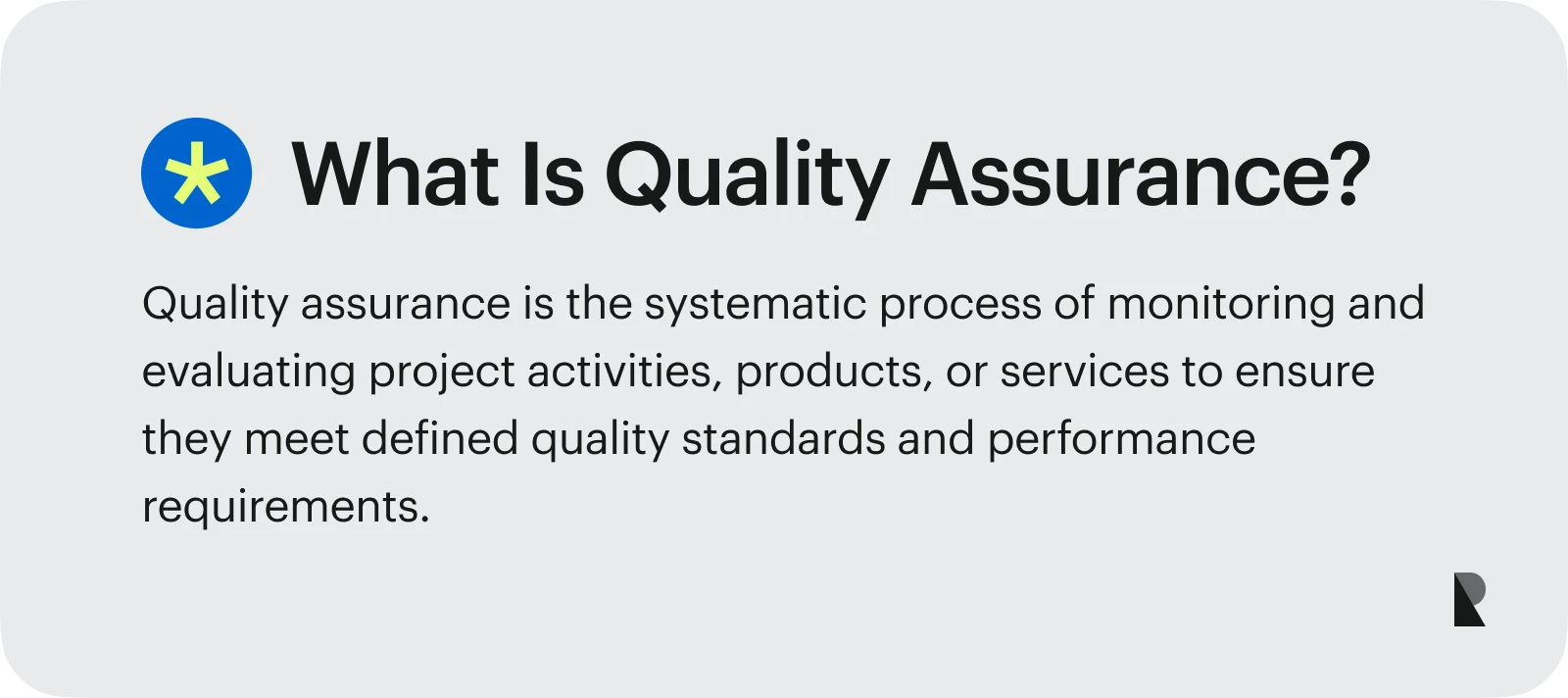
Quality Assurance, or QA, is the discipline that turns intention into reliability. It makes products work, services feel consistent, and brands earn trust. At its heart, QA builds systems that make quality measurable and repeatable.
In business, QA acts as a quiet backbone. It protects creativity from chaos, turning bold ideas into dependable results. Whether it’s an app, a website, or a campaign rollout, QA gives organizations confidence that what they launch will perform as expected.
Defining Quality Assurance
Quality Assurance is a structured process that defines, maintains, and improves product quality from planning to delivery. Its purpose is to confirm that outcomes meet both requirements and customer expectations.
QA is more than just another box to tick before launch: it’s a mindset embedded throughout development and production. It is designed for consistency instead of reacting to flaws. Teams that adopt this approach move faster, waste less, and deliver work that functions under pressure.
QA principles and objectives
Effective QA has four principles: process focus, prevention, documentation, and continuous improvement. These ideas are at the heart of quality management and shape how teams refine their systems. The goal is to monitor and optimize process control, not just the final product. Each review or sign-off becomes part of a repeatable structure that helps teams identify areas for improvement before issues escalate. Prevention almost always costs less than correction, especially in complex workflows.
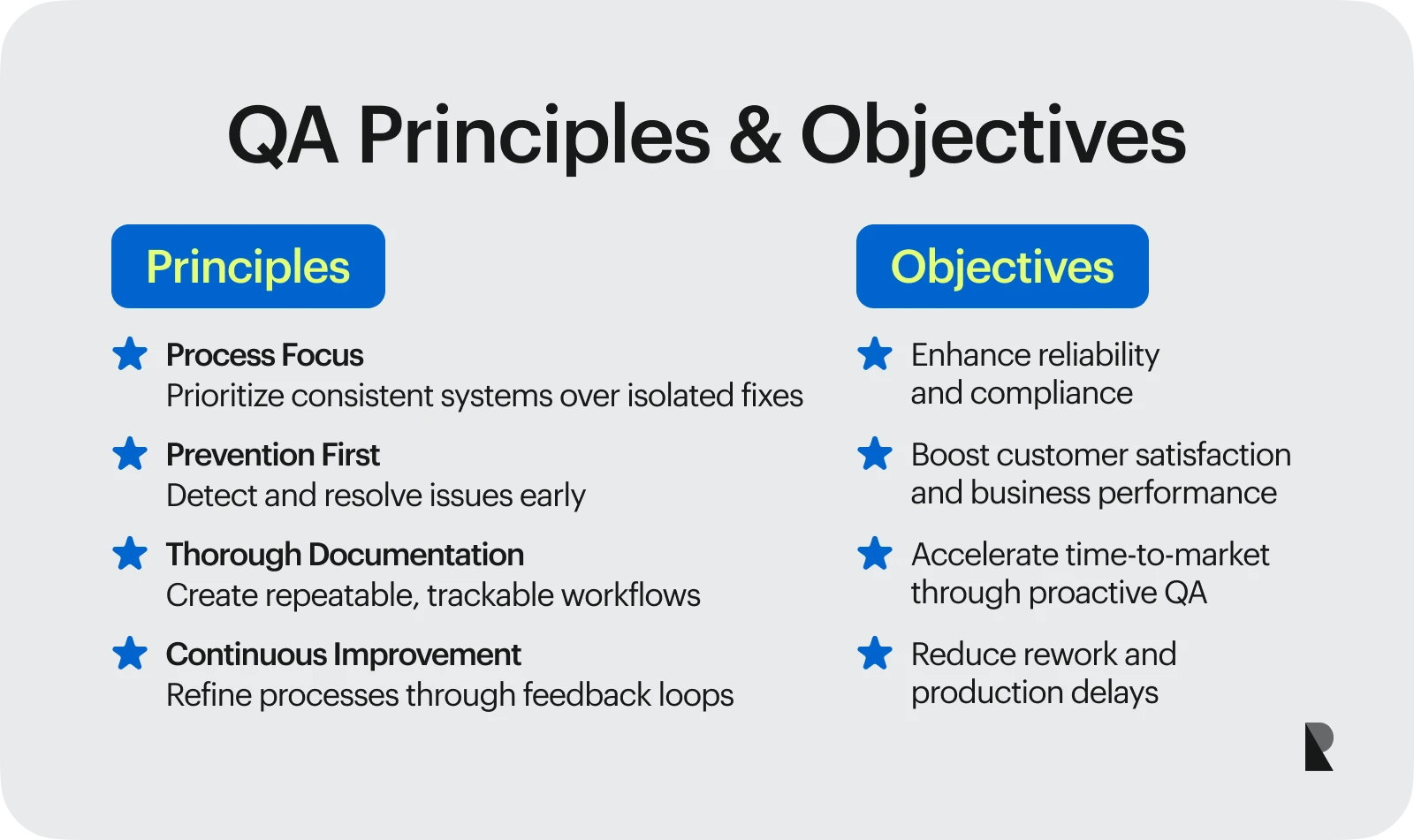
When digital QA occurs early in design, small interventions (like adding Figma comments during the review stage) can reduce reopened design tickets by more than a third. This proves that quality begins long before production even starts.
Companies adopting digital and analytics-driven QA see around 30 percent faster time-to-market and stronger reliability in manufacturing and supply chains. Better QA raises customer satisfaction and lowers compliance risk, showing how deeply it shapes business performance.
Why Quality Assurance Matters in Modern Industries?
Behind every trustworthy brand is a strong QA framework. It keeps experiences consistent across touchpoints and turns reputation into a renewable resource. QA connects artistic ambition with operational discipline in creative environments like design or product studios. It lets teams take bold swings without fearing defects or delivery failures.
At the end of the day, QA reduces risk, raises standards, and anchors management practices, setting you up for long-term success.
Preventing defects vs fixing them
The earlier a defect appears, the cheaper it is to fix. NASA’s Johnson Space Center found that an error caught in the requirements phase might cost one unit to correct, but the same issue discovered after launch could cost more than a thousand times as much.
The pattern repeats in software development. A minor bug that reaches production can multiply costs and erode trust. Teams that build assurance methods into design and build stages avoid the late-stage fire drills that slow projects down. Early QA checks in design tools have been shown to cut rework by half and keep campaign timelines intact. Prevention is more innovative (and far less expensive) than patching mistakes after launch.
QA’s impact on customer satisfaction
Customers rarely praise quality when it works, they expect it. But they notice every delay, bug, and inconsistency. QA reduces those moments of friction and helps experiences feel effortless and reliable.
Organizations that invest in more intelligent QA often see smoother operations and stronger emotional loyalty. Consistency turns satisfaction into trust. Every skipped QA step carries a price tag; catching those gaps early can prevent costly mistakes.
Quality Assurance vs. Quality Control
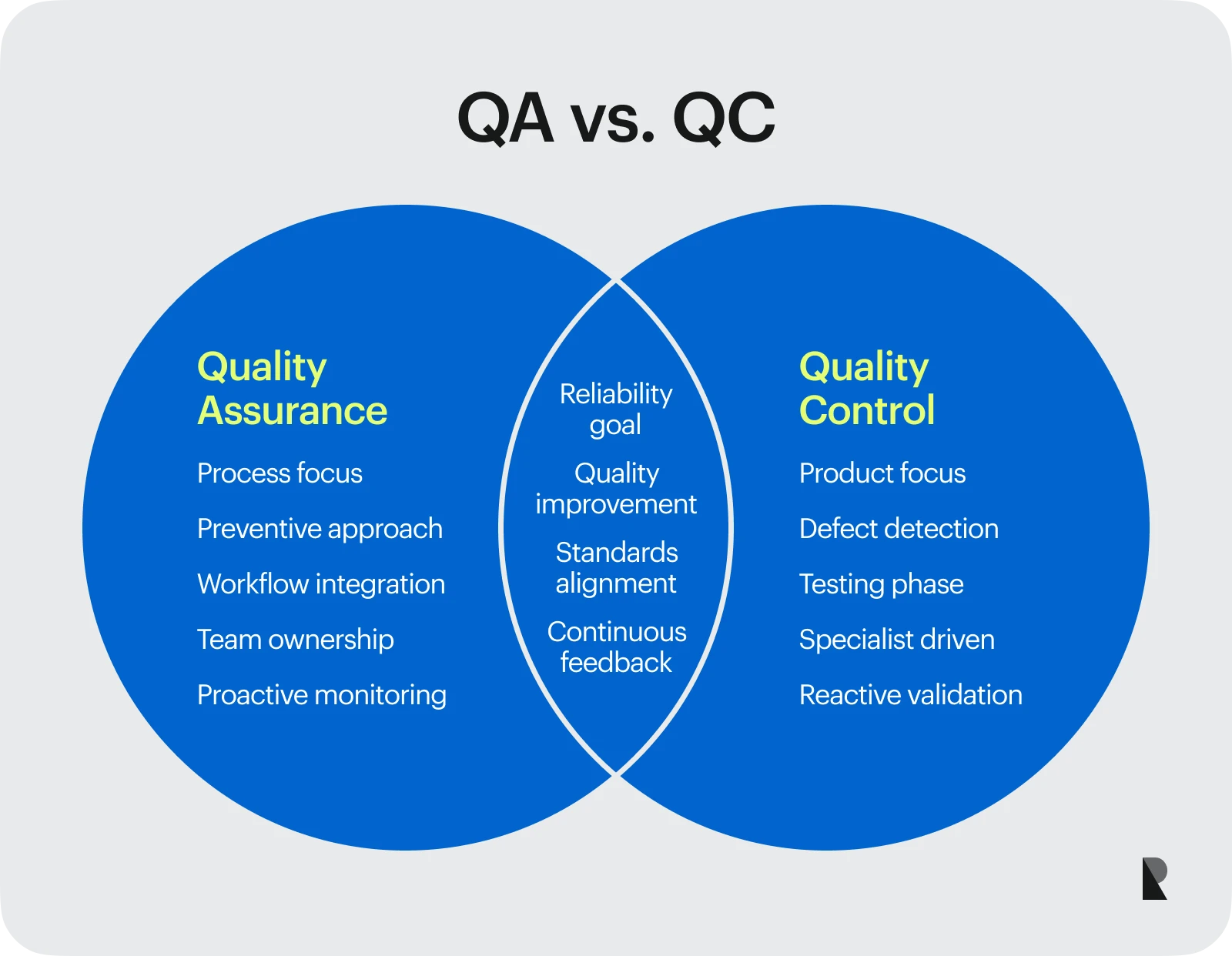
While the terms sound more or less the same, quality assurance and quality control play different roles. QA is the strategy that defines how to achieve reliability; QC is the verification that standards were met.
| Aspect | Quality assurance (QA) | Quality control (QC) |
|---|---|---|
| Focus | Process and prevention | Product and detection |
| Goal | Embed quality into workflow | Verify final output |
| Ownership | Shared across teams | Testing specialists |
| Timing | Proactive and ongoing | Reactive after completion |
QA builds confidence in how things are made; QC confirms the result. Combined, they create the feedback loop that sustains long-term consistency.
Common QA Standards and Frameworks
Several global frameworks define good QA and keep quality standards consistent across industries.
- ISO 9001 sets the benchmark for quality management, focusing on leadership, documentation, and continuous improvement.
- CMMI (Capability Maturity Model Integration) helps teams assess their processes and mature them systematically. It is widely used in software and engineering.
- Six Sigma minimizes variation and defects through data-driven decisions, often applied in production and process-heavy environments.
These frameworks formalize what effective QA already achieves in practice: a shared language of reliability that translates across sectors.
Defining Software Quality Assurance (SQA)
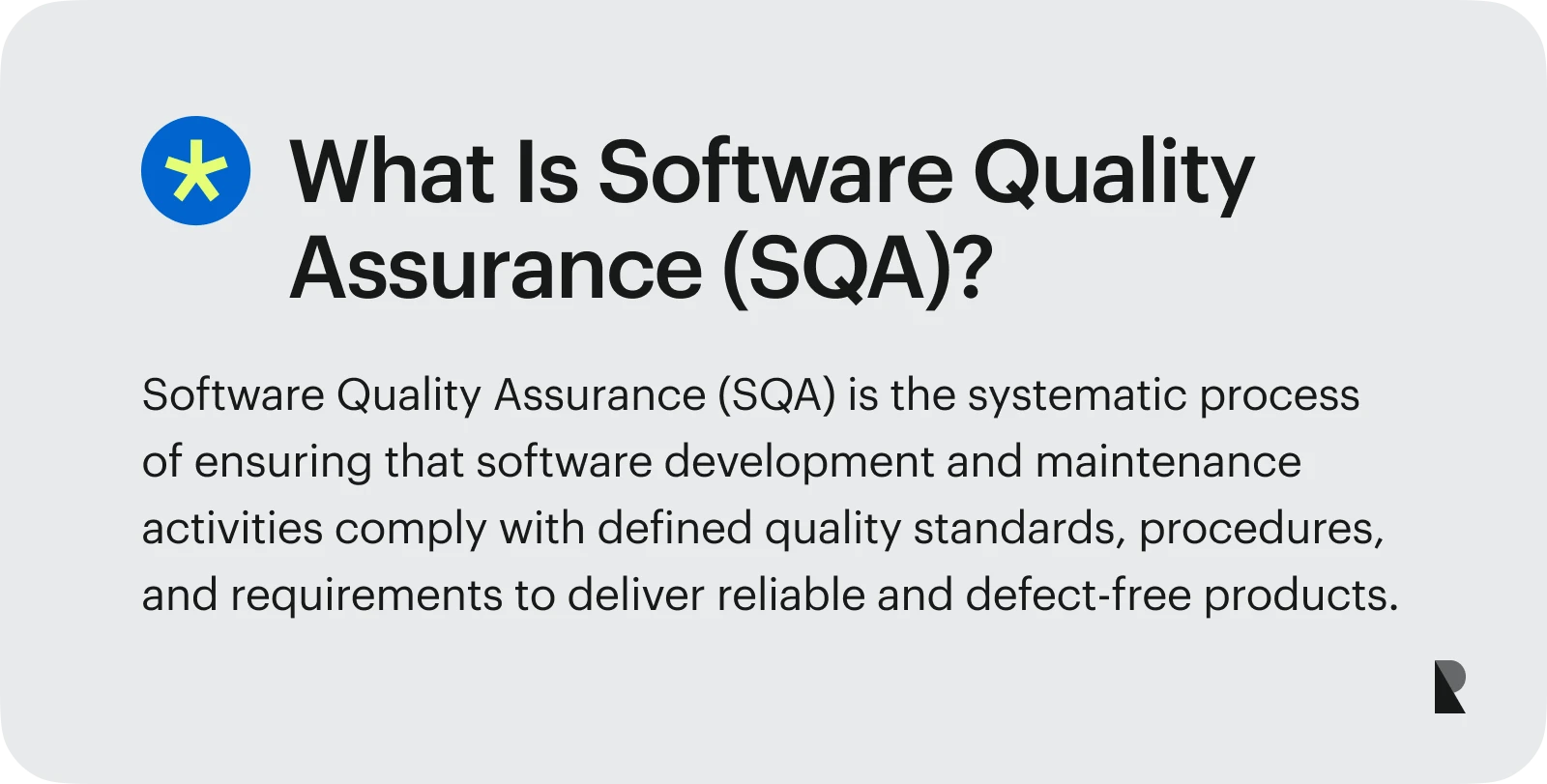
Software Quality Assurance (SQA) applies QA principles to software development, focusing on compliance, security, usability, and reliability. It’s designed to build quality into processes instead of chasing defects after release.
SQA combines structured reviews, audits, monitoring, and coding standards to maintain consistency and process control. Typical QA teams include testers, engineers, analysts, and managers, each responsible for validation, automation, reporting, and oversight.
Modern SQA uses automation tools like Selenium, TestRail, and Jenkins to test and track real-time performance. When integrated with design and operations, this approach can reduce defects by over 30 percent and cut design rework by nearly half.
QA vs. Software Testing
Quality Assurance and software testing are closely connected, yet their focus and intent differ. QA is the overarching strategy that defines how quality is achieved, while testing is the step that validates whether those expectations are met.
Testing searches for defects, while QA prevents them. The difference is philosophical: QA asks how to build quality into a process, while testing asks whether that quality exists in the final product. Well-designed QA systems make testing faster, more accurate, and less expensive. That relationship explains why organizations with mature QA frameworks deliver stronger, more consistent results across projects, campaigns, and platforms.
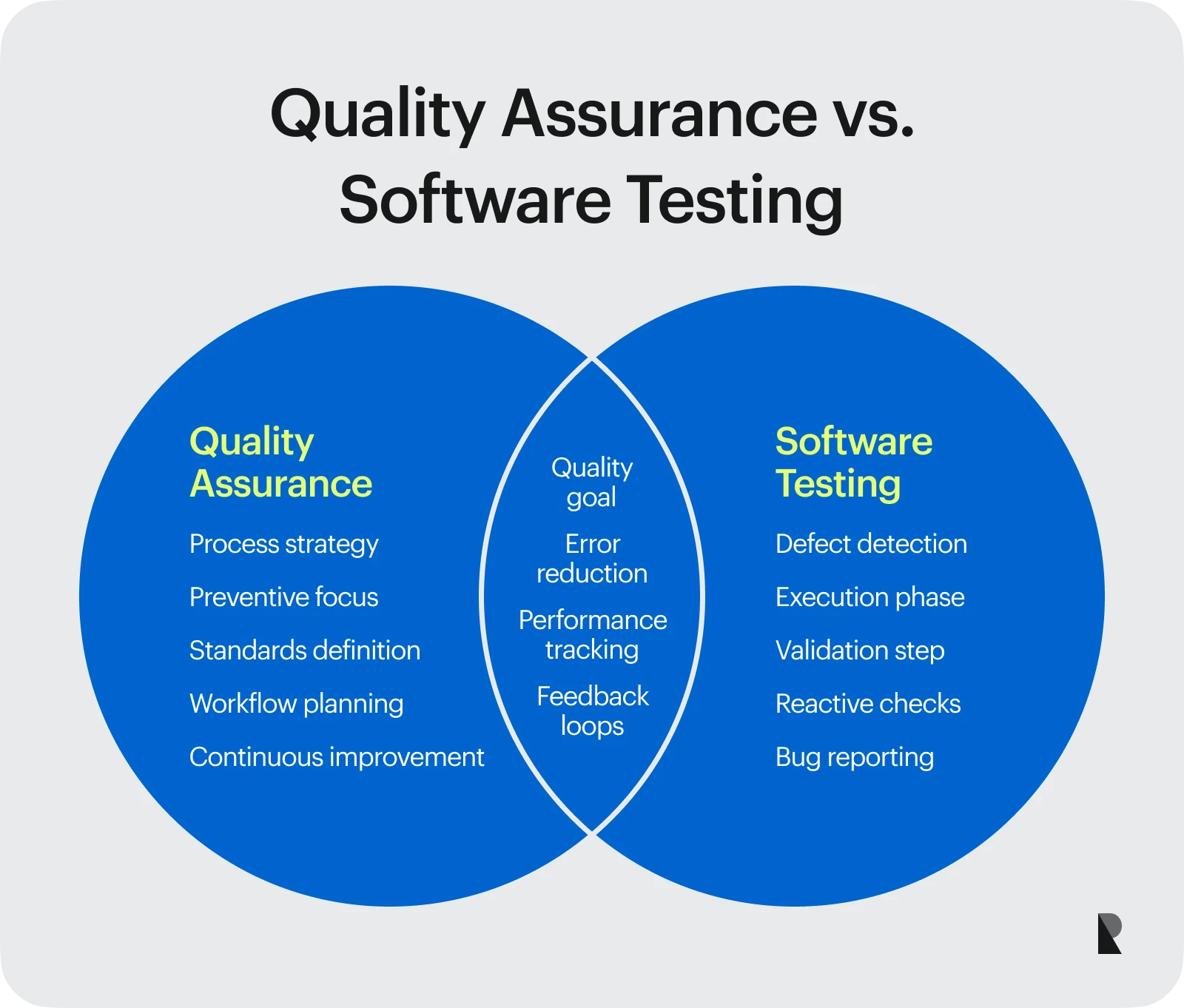
Process vs execution
QA is the process of planning, documenting, and refining how quality is achieved. It defines the structure, standards, reviews, and metrics, which shape every stage of development. Testing, on the other hand, is execution. It’s where those standards meet reality.
The most effective teams weave QA throughout their workflows, not just at the end. Designers run visual reviews before handing files to developers, engineers run unit tests alongside coding, and project leads use feedback loops to analyze recurring issues. The result is smoother delivery and fewer surprises.
When QA checkpoints appear early, feedback feels collaborative, not corrective. This shift from postmortem to partnership marks the difference between reactive control and proactive improvement.
Prevention vs detection
Prevention embeds quality from the start, and detection corrects it afterward. QA defines the preventive measures: design reviews, documentation, automation, and real-time checks, while testing identifies what escaped the net.
Both are vital, but prevention creates long-term value. A single bug discovered in early design may take minutes to fix; once deployed, it can take days and cost thousands. Teams that align prevention with creativity gain a competitive edge: build faster without sacrificing precision.
Pros and Cons of Implementing QA
Adopting QA across an organization is a cultural shift. It introduces structure, accountability, and discipline, which can initially feel like friction. But that friction is precisely what polishes the outcome.
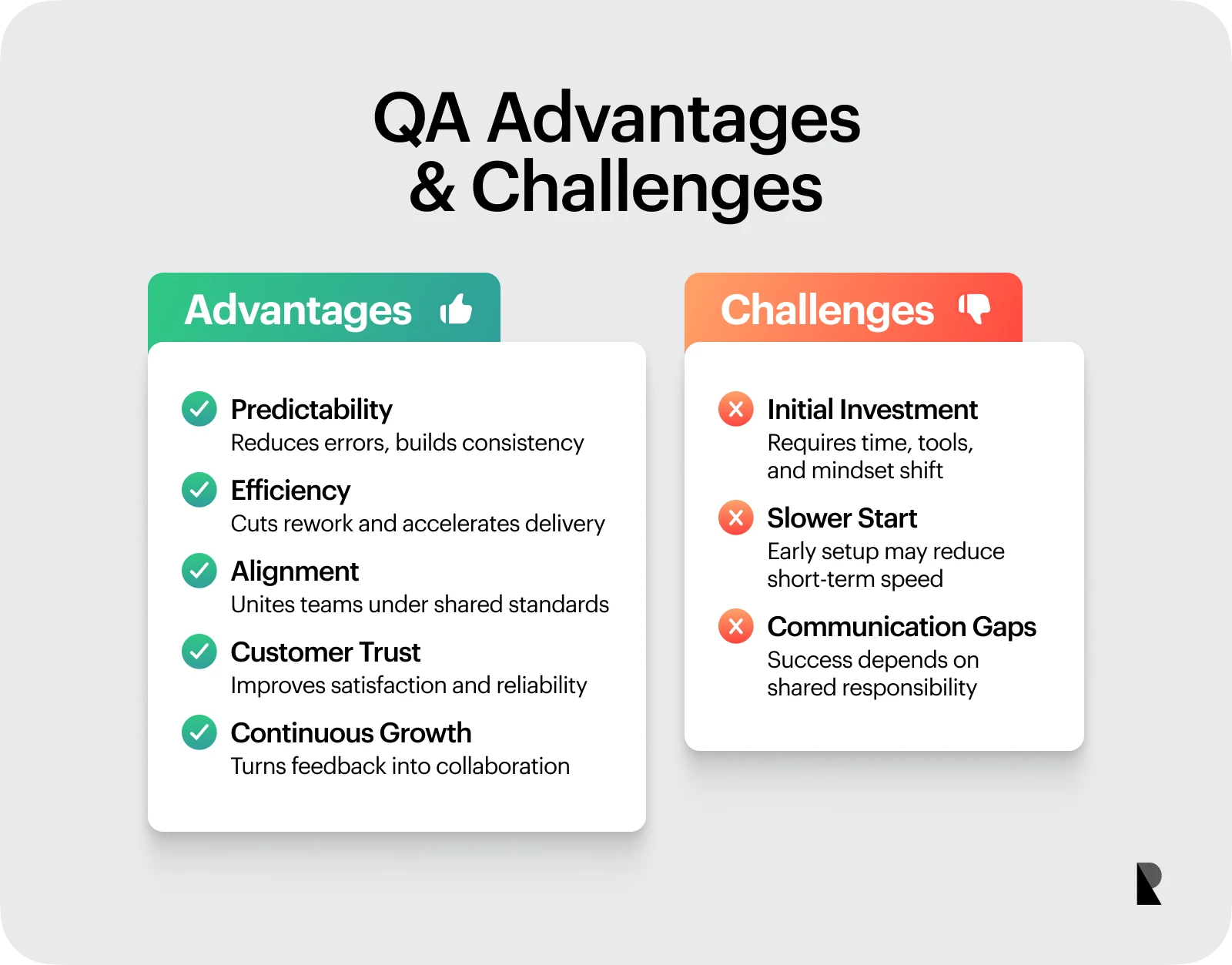
QA advantages
The advantages of Quality Assurance compound over time. QA builds predictability, lowers risk, and increases production efficiency. It creates alignment between teams, providing shared standards guiding execution and creativity.
When companies introduce digital QA systems, the payoff is tangible. Organizations using analytics-driven QA achieve faster time-to-market and higher customer satisfaction while improving supply-chain reliability and employee engagement.
The same is true in design-led industries. Early QA review cycles in tools like Figma have been shown to reduce reopened design tickets by roughly 35 percent and cut design rework by half. These aren’t abstract metrics but measurable results that strengthen product quality and client trust.
Over time, QA becomes self-reinforcing. The more consistently teams apply it, the more intuitive it feels. Feedback turns from critique into collaboration, and quality becomes part of the rhythm of work.
QA challenges
Quality Assurance demands investment in time, tools, and mindset. Building a QA team or process can initially slow momentum, but this pause prevents last-minute breakdowns later.
Communication is often the biggest challenge. QA succeeds when everyone owns it, not when it’s delegated to one department. A designer checking spacing, a developer testing code, and a project manager reviewing handoff files all participate in the same quality ecosystem. The cost of skipping QA, however, is far higher. QA isn’t overhead; it’s protection.
Evolution of QA and ISO’s Role
QA has evolved alongside the industries it supports, from craftsmanship in the Middle Ages to digital production pipelines.
History of QA
Guilds introduced early quality control forms in the Middle Ages by regulating craftsmanship and trade standards. With the rise of industrial production, inspection systems emerged to maintain consistency. But as production scaled, inspection alone wasn’t enough.
In the 20th century, thinkers like W. Edwards Deming and Joseph Juran reframed quality as a management philosophy. They introduced statistical process control, the use of data to identify variation, and total quality management, which embedded improvement into leadership culture.
When software development arrived, QA shifted from physical inspection to process design. Agile and DevOps methodologies brought faster release cycles, demanding real-time monitoring and continuous improvement. Today, QA and software development operate hand in hand, one focused on building, the other on sustaining.
ISO’s contribution
The International Organization for Standardization (ISO) helped unify global quality efforts. ISO 9001 became the foundation of modern quality management by codifying principles such as leadership, customer focus, and documented processes.
ISO’s influence extends across sectors, from manufacturing to software, providing a language shared for reliability. It also inspired complementary frameworks like Six Sigma and CMMI, which combined statistical process control with organizational improvement. Thanks to ISO, QA became measurable and transferable. It turned “doing things right” from intuition into an international standard.
Best Practices in Quality Assurance
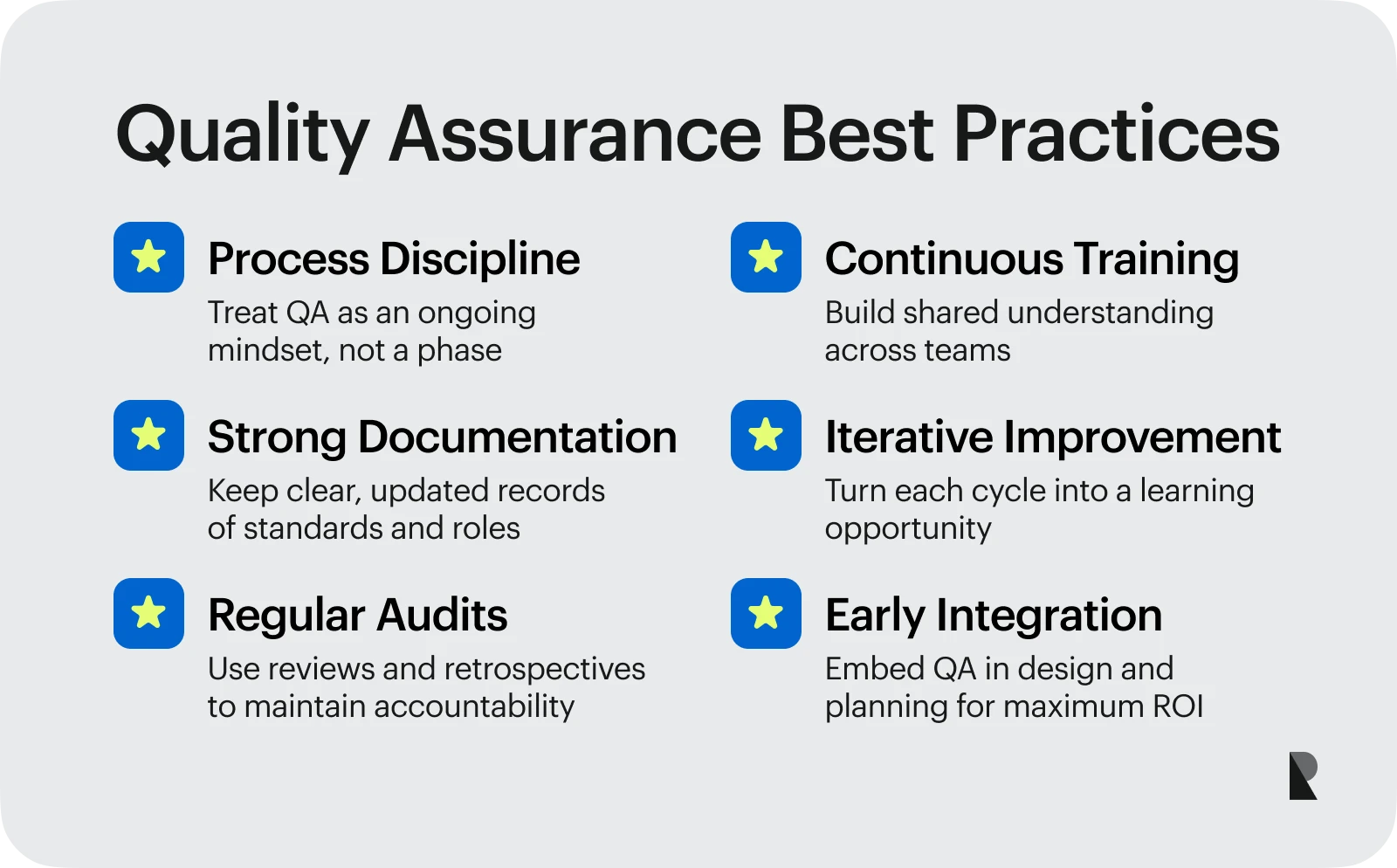
Good QA isn’t built on tools alone. Habits sustain it. The most effective organizations approach QA as a continuous discipline rather than a one-time phase. Documentation remains the backbone. Clear, current records of processes, responsibilities, and criteria reduce ambiguity. Regular audits and sprint retrospectives keep standards active instead of theoretical. Ongoing training helps every team member understand how their work contributes to collective quality.
Continuous improvement ties it all together. Each cycle produces insights that strengthen the next loop, gradually raising the bar. Over time, minor refinements create significant advantages. This mindset pays off financially, too. When QA and design operations merge early in the workflow, companies can save $24 for every $1 invested during design and planning. That’s the compounding power of getting quality right from the start.
Types and Methods of QA
Organizations tailor their assurance methods based on size, risk, and industry. Preventive QA focuses on avoiding issues before they appear, defining standards, conducting training, and refining processes. Corrective QA reacts to discovered issues, analyzing them to prevent recurrence. Risk-based QA prioritizes critical areas, investing resources where failure would be most damaging. Agile QA integrates prevention and correction into iterative, flexible cycles.
Together, these approaches form a dynamic system of checks and balances. Quality becomes not a phase, but a continuous pulse running through the workflow.
The role of QA teams
Behind every strong QA system is a coordinated team. A QA specialist defines methods, testers perform validation, engineers develop automation scripts, and managers maintain oversight. Analysts interpret patterns and identify areas for improvement.
In creative industries, these teams work closely with design and production leads to maintain visual consistency and usability. Real-time collaboration reduces bottlenecks, speeds up delivery, and improves transparency. Quality becomes invisible when QA teams operate in tandem with design and development, not because it’s absent but embedded everywhere.
Conclusion
Quality Assurance is more than process control; it’s a promise. It turns ambition into reliability and creativity into credibility. Organizations that invest in quality assurance and management systems gain much more than efficiency. They build trust internally with their teams and externally with their customers.
The future of QA will be defined by integration and intelligence. QA will move from reactive testing to predictive insight as analytics, automation, and real-time feedback evolve. But even then, its core remains human: a shared commitment to doing things right before they reach the world. QA is not just what keeps things from breaking. It’s what makes excellence repeatable and brands unforgettable.
If you’re building a digital product or brand experience and want to integrate QA from the first design sketch to final delivery, explore how Ramotion can help. As a leading UI design agency, we connect creativity with precision, assisting brands to deliver digital experiences that perform beautifully. Explore the top UI/UX design companies shaping modern interfaces that unite quality, usability, and innovation to see how others do it.
Oct 21, 2025
